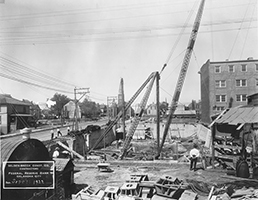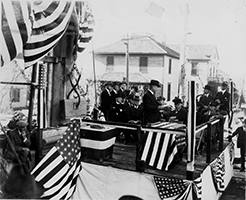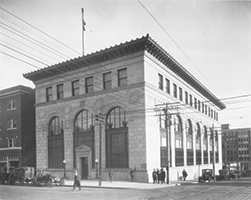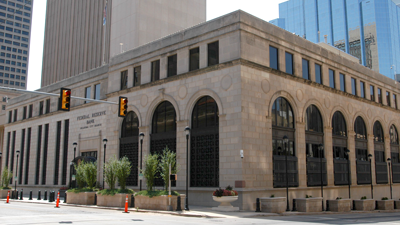A Timeline of OKC Branch History
12/23/1913
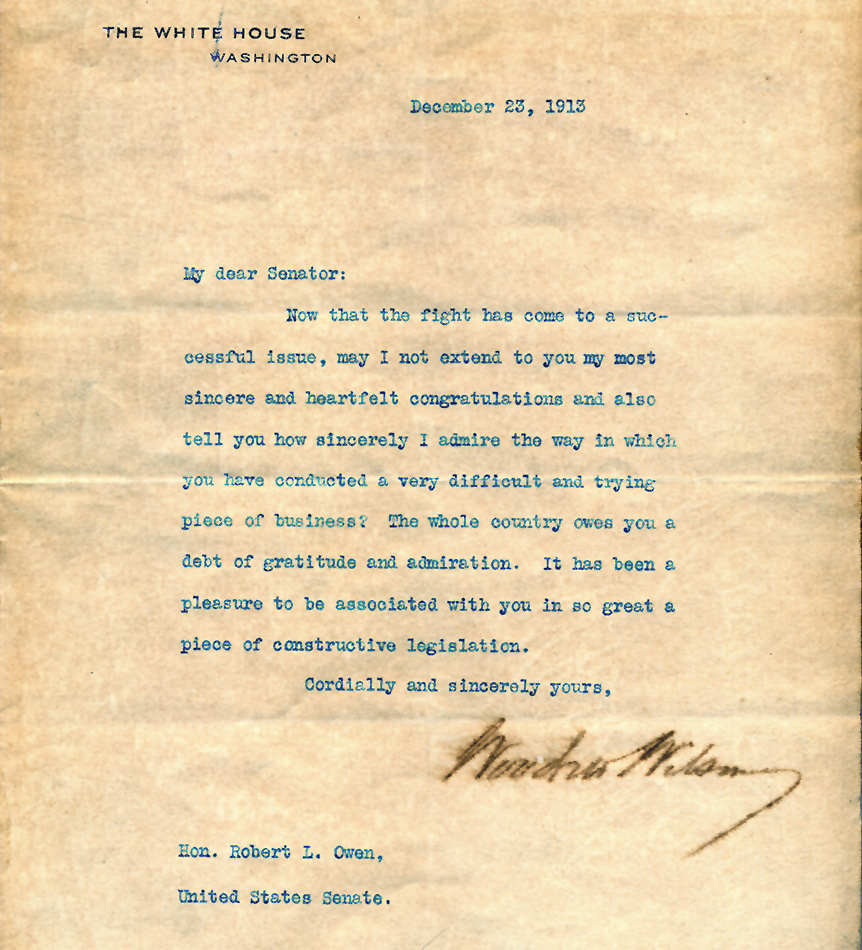
The Federal Reserve Act
Congress created the Federal Reserve in 1913 to bring financial stability after a number of banking panics.
The Federal Reserve System’s original responsibilities gave the country an elastic currency, facilities for discounting commercial paper, and improved the supervision of banking. The three original goals have expanded; today, the system exists to help achieve four primary economic goals: stable prices, economic growth and stability, high employment, and balance of international accounts.
11/16/1914
Banks Open
The Federal Reserve Banks formally opened at approximately 10 a.m. The opening date for Federal Reserve Banks is nearly five months ahead of schedule due to fears of a possible panic caused by war in Europe. It is an inauspicious first day of operations for the Federal Reserve Banks with little fanfare and only a small trickle of business.
The FRB Kansas City opens in the R.A. Long building at 928 Grand Blvd, on the northwest corner of 10th and Grand.
1908
The Aldrich-Vreeland Act
After the Panic of 1907, the legislation provided for the issuance of emergency currency and created the National Monetary Commission to determine what changes might be needed to the monetary system and laws related to banking and currency.
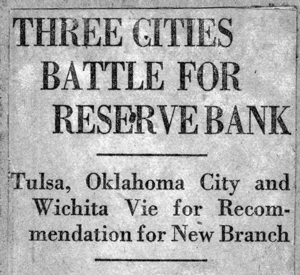
6/19/1919
Oklahoma
Oklahoma City and Tulsa both submit applications to be a branch location of the Kansas City Federal Reserve.
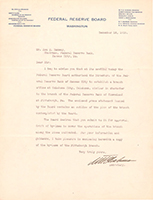
12/17/1919
Branch Location Chosen
The Federal Reserve Board issues an order directing the FRB Kansas City to establish a branch office at Oklahoma City. The goal was to expedite shipments of currency to and from member banks in Oklahoma and for intra-state clearing of checks, with the caveat that the branch could be discontinued if operations were found unsatisfactory.
The decision on the Oklahoma City Branch location was postponed until Nebraska and Colorado established branches.
8/2/1920
OKC Branch Opens
Oklahoma City Branch opens with offices on the second floor of the Continental Building at Second and Broadway and a vault in the basement of the American National Bank at Robinson and Main.
The original staff’s purpose was to collect checks and redeem United States currency.
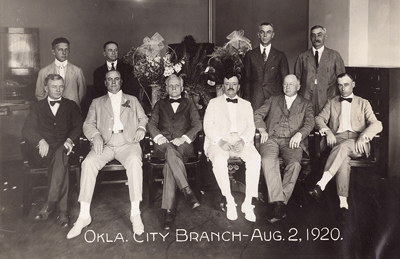
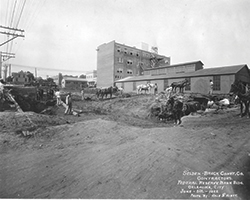
1921
Property Purchased
Property at the corner of Third and Harvey Streets is purchased at a cost of $65,000 as the site of a permanent home for the Oklahoma City Branch.
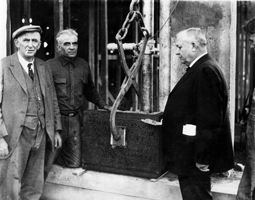
12/7/1922
The Cornerstone is Laid
The cornerstone was laid by W.J. Bailey, governor of the Federal Reserve Bank of Kansas City. A trowel presented by the Oklahoma City Clearing House Association was used to lay the cornerstone. Included were small quantities of minerals and agricultural products representing Oklahoma resources, and The Daily Oklahoman and The Oklahoma Times.
5/1/1923
Branch Opens
Oklahoma City Branch building at 226 NW 3rd Street opens. The location was 39,000 square feet and included 40 employees and four officers.
1923
The Vault
Since Oklahoma was an exceptionally rich and thriving state, the amount of money kept in the bank’s vaults would be unusually large - between four and five million dollars in federal reserve notes and other forms of national exchange.
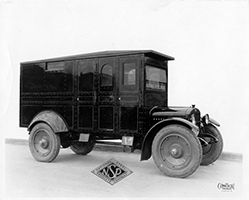
1923
Armored Truck
An armored truck was purchased for hauling currency. It had the new safety and security features with a speed of thirty miles per hour and a one-ton capacity.
1924
10th Anniversary
The Federal Reserve System and Federal Reserve Banks celebrate 10th anniversary.
The Oklahoma City Branch Board of Directors is expanded from five to seven members, including both bankers and non-bankers.
1935
Federal Reserve Bank Club
Oklahoma City Branch started the Federal Reserve Bank Club with president C.N. McCabria. The club received profits from the selling of candy bars around Christmas, and from the soft drink machine installed on the second floor. The profits were then reinvested back into the branch employees. Some of the gestures included buying retirement gifts, sending flowers, get-well cards and expressions of sympathy on appropriate occasions.
12/8/1941
Country at War
U.S. enters World War II as allies, with the exception of the Soviet Union, declare war on Japan.
1945
Branch Groups
The last OKC Club meeting is held.
Oklahoma City forms the 25 year club. Kansas City formed its 25 year club in 1944.
By 1945, the Oklahoma City Branch staff had reached 175 employees.
1946
New Cafeteria
A new full service cafeteria opens at Oklahoma City Branch. It is the Branch’s first cafeteria.
The menu consisted of soups, salads, sandwiches, desserts and beverages with prices ranging from five to ten cents per item.
1950
Property Purchased
The site behind OKC Branch building was purchased for the location of a building addition consisting of 5 stories and a basement.
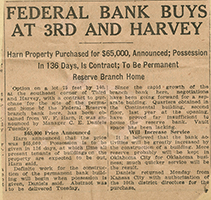
1958-1960
Expansion
Plans for a remodeling and expansion are announced by President Leedy.
The Harn Building is purchased.
Expansion of the building begins with demolition of the Harn Building. The construction will add 48,000 square feet and three floors at the cost of $2.3 million.
1962
The Oklahoma City Branch is one of the three branches in the Tenth Federal District.
Staff members at Denver, Oklahoma City and Omaha are paid in cash. Staff members at the home office receive their first payday by check.
Member bank accounts have grown to $499 million. Check collection averages 750,000 items daily. Currency transactions average more than $181 million each month.
There are more than 220 employees and 4 officers.
9/13/1962
Vault Floods
Oklahoma City Branch basement vault was flooded as a result of an unexplained break in a main water line.
The millions stored in the flooded area remained dry because they were stored in containers. Elevators and the air conditioning system were also knocked out for the day.
12/6/1962
New Branch Opens
After 2 years the new Oklahoma City Branch opens.
The old building was completely remodeled and incorporated into the new three-story addition containing an additional 48,000 sq. ft. The old vault was left intact, but an even larger vault was added across a corridor from the old one.
The new vault had four time locks and four sets of combination locks.
Directors from the head office and other branches came for a joint meeting of the boards. Nearly 200 bankers from all parts of the state journeyed to Oklahoma City to see the Fed’s newest quarters.
There are currently more than 175 employees and 4 officers working at the branch.
1964
District Ten-J celebrates its 50th anniversary.
A high-speed check processor comes to Oklahoma City.
1970
The Oklahoma City Branch cafeteria begins selling self-service breakfast items. Hard-boiled eggs seventy cents, bacon is seven cents/slice, and dry cereal ten cents.
Reserve deposits of member banks have increased from $14 million in 1920 to approximately $247 million in 1970. In 1970 the branch processed an average of 341,000 checks daily to 39,000 checks daily in 1920.
The “pant suit” is now considered proper attire at the Oklahoma City Branch for women. A committee, composed of one woman from each department, was formed to resolve any questions arising out of the interpretation of the guidelines and to ensure that they are uniformly adhered to throughout the bank.
1976
Soda machine prices increase from ten cents to twenty cents. Quite an uproar followed!
A $2 million renovation project is approved. This project would include consolidation of coin and currency operations and the relocation of the Securities Department. It would also expand Data Processing and Check Collection.
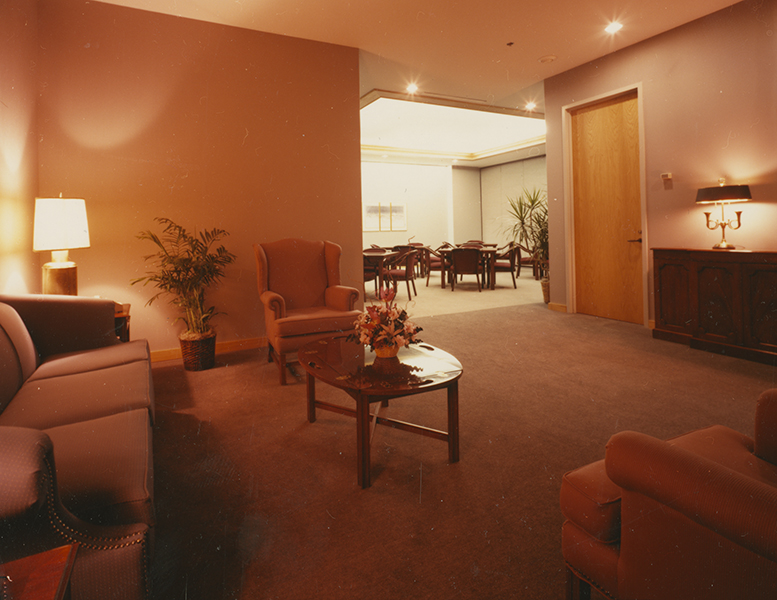
1977
Remodel
The building undergoes a $2 million remodeling project. An underground firing range and off-site backup diesel-powered generator were a few of the new additions. A coin vault was installed. All coin deposits from and shipments to financial institutions are processed in the vault.
1978-1979
The Oklahoma City Branch no longer receives Savings Bonds. All Savings Bonds are to be centralized at the Kansas City office.
Oklahoma City and Denver Branches begin destroying unfit money in a “disintegrator” rather than by incineration, which results in pulp instead of ashes as a result of environmental control concerns.
7/5/1982
Penn Square Bank
Penn Square Bank in Oklahoma City is declared insolvent. Over the July 4 weekend, Federal Reserve Bank of Kansas City officials were involved in an intensive review of Penn Valley’s assets in order to determine whether or not the Kansas City Fed’s lending facilities could be extended in an attempt to save Penn Valley. The later failure of Continental Illinois National Bank and Trust of Chicago, the then seventh largest bank in the United States, was attributable, in part, to the sale of energy loan participations by Penn Square Bank.
12/25/1983
Water Valve Break
Sub-zero temperatures caused a main water valve to break at the branch flooding the vaults in the basement. Time locks on the vaults prevented access to the vaults until the Tuesday after Christmas, at which time water poured out of the vaults when they were finally opened. The flood resulted in the destruction of more than $25 million in currency, 2,063 soaked bags of coins (sent to the Mint for drying, cleaning and rebagging), knocked out the CVSC high-speed currency sorter, warped wooden desks and destroyed other office equipment.
5/21/1984
Counties Join 10-J
Eight counties in the southeastern corner of Oklahoma are moved from the Dallas Federal Reserve Bank (11th District) to the Kansas City Federal Reserve Bank (10th District).
The counties affected were Johnston, Coal, Atoka, Pushmataha, McCurtain, Choctaw, Bryan and Marshall.
1987
Changes Around the Branch
Smoking is prohibited in the branch cafeteria except for designated tables. A new employee dining facility opens. Perks include a grill for eggs cooked to order, hamburgers and onion rings available three times per week.
Sadly, there is no longer room for the branch’s pool tables. They are auctioned off to branch bidders.
Employees and family toured the Fed to get a glimpse of the bank and show off the newly remodeled 3rd floor. The theme of the event was “Hats the Federal Reserve Wears” and guests were handed Bank tour maps modeled after a monopoly board.
10/19/1987
Black Monday
Known as Black Monday, markets worldwide tumble and the Dow Jones Industrial Average sheds more than 20 percent of its value, falling 508 points to 1,738.74.
1989
The Electronic Payments Department processes a daily average of 38,000 items amounting to $28,000,000. [Source: OCB. 08/18/89] The Cash Services Department processes an average of 840,000 notes each business day on the Currency Verification. [Source: OCB. 9/15/89] The Accounting Department is the central point for the daily processing and balancing of approximately 16,000 entries to 160 general ledger accounts of 321 financial institutions; and 5,000 entries to the accounts of the other Federal Reserve Banks. [Source: OCB. 09/28/89] Examinations and Inspections Department conducts over 140 bank holding company inspections and participates in 22 bank examinations in 1989. [Source: OCB. 12/08/89] The paying tellers in the Cash Services Department paid out $2,300,000,000 to financial institutions. That is 180,919,000 pieces of currency. [Source: OCB. 04/13/90]
3/31/1989
The Public Affairs Department is established at the branch to assist Kanas City’s efforts in improving the public’s understanding of the purposes and functions of the Federal Reserve System.
10/16/1989
At 10:12p.m., a 2,500 pound concrete panel from the adjacent building falls onto the roof of the Oklahoma City Branch building demolishing the cooling tower and placing the air conditioning out of commission. “All employees dealt with hot, unventilated work areas, limited cafeteria service, and change in parking venues”.
8/11/1990
Softball Game
The first Officer/Manager vs. Employee softball game takes place.
10/1991
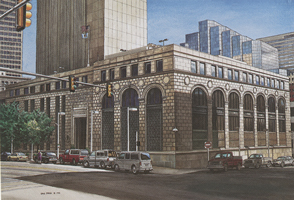
Renovation
The architectural firm HTB comes in and presents the bank with a variety of options for rearranging each floor to address renovation needs. The goal is to renovate the interior of the existing building and preserve the historical exterior in the process.
1993
Check Delays
The high-speed check processing equipment in the Check Collection Department shuts down, resulting in delays to processing “City” checks. With approximately $65 million worth of checks left to process questions arose as to whether or not they would meet their 2 p.m. deadline. With everyone’s help the deadline was met.
1994
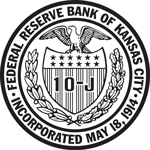
The Federal Reserve System returned $20 billion to the U.S. Treasury.
The Oklahoma City Branch seal was created.
Work begins for the central plant upgrade and first floor renovations. Costs are estimated at $7.5 million. The branch will have new central plant equipment, an improved security system, an esthetically pleasing and functional lobby and departmental spaces, and additional meeting space.
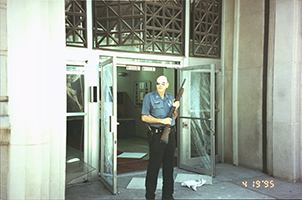
4/19/1995
The Murrah Bombing
At 9:02 am, a large bomb decimates the Alfred P. Murrah Federal Building in Oklahoma City, killing 168 people. The Oklahoma City Branch suffers relatively minor damage. The event results in the closure and evacuation of the building. The building was in full operations two days after the bombing.
1995
The firing range is remodeled. The most significant change to the range is the new target system.
11/16/1995
The second phase of renovations begins. This includes renovation of the basement and second floors. Costs are estimated at $5.4 million.
The Branch marks its 75th anniversary.
1996
Cash Services employees handle an average of 16,000 bags of coin each month. The Check Services Department has the largest staff at the branch.
1997
The Check Services Department converts to new processing system CPCS.
The final portion of the renovation projects are completed by 1997.
1998
The first edition of ComLink, a bi-weekly publication intended to provide brief, concise and up-to-date business information, is published.
The US Postal Service issues a Federal Reserve stamp.
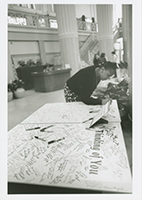
5/3/1999
May 3rd Tornado
A tornado first touches down southwest of Chickasha, and becomes an EF5 before dissipating over Midwest City, after tearing through Bridge Creek, Oklahoma City, Moore, Del City, and Tinker Air Force Base. Thirty-six die as a result of the tornado, with over 8,000 homes badly damaged or destroyed.
2001
The Oklahoma City Branch begins publishing an employee newsletter titled Oklahoma City Branching Out (this publication replaces Oklahoma City Update.)
9/11/2001
9/11
Terrorists attack. To deter a panic among financial institutions following the attacks on New York City and Washington, D.C., the Fed releases this statement: “The Federal Reserve System is open and operating. The discount window is available to meet liquidity needs.”
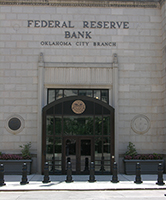
2003
Security Measures
Planters and bollards are installed to prevent a vehicle from driving through the building. The bollards are steel pipes laid in concrete eight feet deep.
FedImage
The Oklahoma City Branch leads transition to FedImage, an image services product suite that provides customers a total image management solution.
2004
Branch Changes
In 2004, the Branch staffing level was at 165 employees. Check volume was 1.2 million items per day, and currency processed averaged 1.4 million notes per day.
The Accommodations Teller Window closed operations to reduce support-related expenses to the Branch.
The Oklahoma City Branch receives a Perfect Partnership Award by the Oklahoma City Public School Foundation for its work with its Partners in Education school, Dunbar Elementary.
Branch Efficiency
Oklahoma City Branch posts the highest BPH (bundles processed per hour) average, at 81.3, for the year. The Omaha Branch comes in third, with 79.4 BPH, while the Kansas City and Denver offices came in 15th and 18th, respectively. The Tenth District ranks second overall with a BPH of 78.0 right behind the Sixth District (Atlanta Fed) at 78.1 BPH.
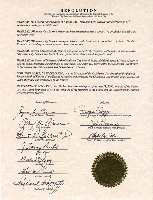
2004
85 Years
The Oklahoma City Branch celebrated its 85th anniversary with an evening reception for employees and guests. The event included a department functions overview; a comedic video about the path of a check; tours of cash, the Protection firing range and Facilities Management work areas; and a “photograph museum” from the past 85 years.
2005
Check processing operations close at the Oklahoma City Branch consolidating into the Federal Reserve Bank of Dallas. This resulted from the changes in the nation’s payment system. The use of credit cards, debit cards and online bill payment by consumers.
“Check services in a dying business and the Federal Reserve System must make changes to recover our costs as mandated in the Monetary Control Act.”- Branch President.
12/9/2005
The Branch said farewell to 44 employees who had serve a collective 791 years, with an average individual tenure of 16 years. Employees had opportunities to participate in several benefits education and career transition activities, including resume writing and interviewing skills workshops.
The Federal Reserve System announces that cash services provided to financial institutions by the Oklahoma City Branch of the Kansas City Federal Reserve Bank will transition to a cash depot arrangement with service provided by the Dallas Federal Reserve Bank.
The new Oklahoma City Branch model was established.
2006
The Regional Affairs Department opened at the Oklahoma City Branch.
The Branch building is sold.
By the end of 2006 the Cash, Protection, Check and Facilities departments had been dissolved leaving approximately 35 employees.
The Branch celebrates the opening of the newly-renovated building with a ribbon cutting and open house. All branch departments are now located on the third floor. The facility is approximately 22,000 sq. ft. The Oklahoma City Branch seal is installed in the floor of the elevator lobby.
2/1/2011
Thomas M. Hoenig reaches the mandatory retirement age of 65 after serving 20 years as the President of the Federal Reserve Bank of Kansas City (the longest tenure of any KC Fed CEO to date.)
10/01/2011
Oklahoma City Branch launches its Student Board of Directors Program.

